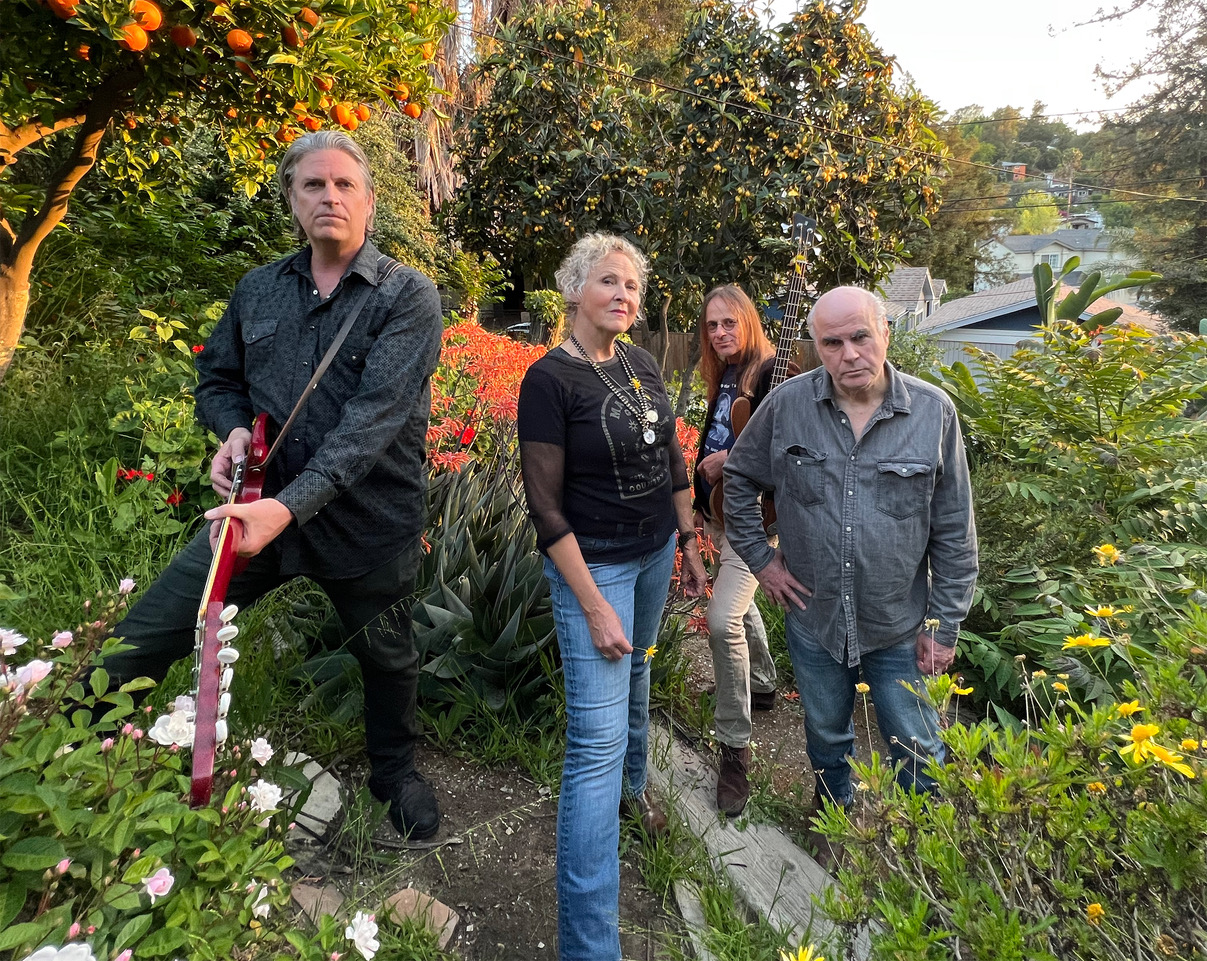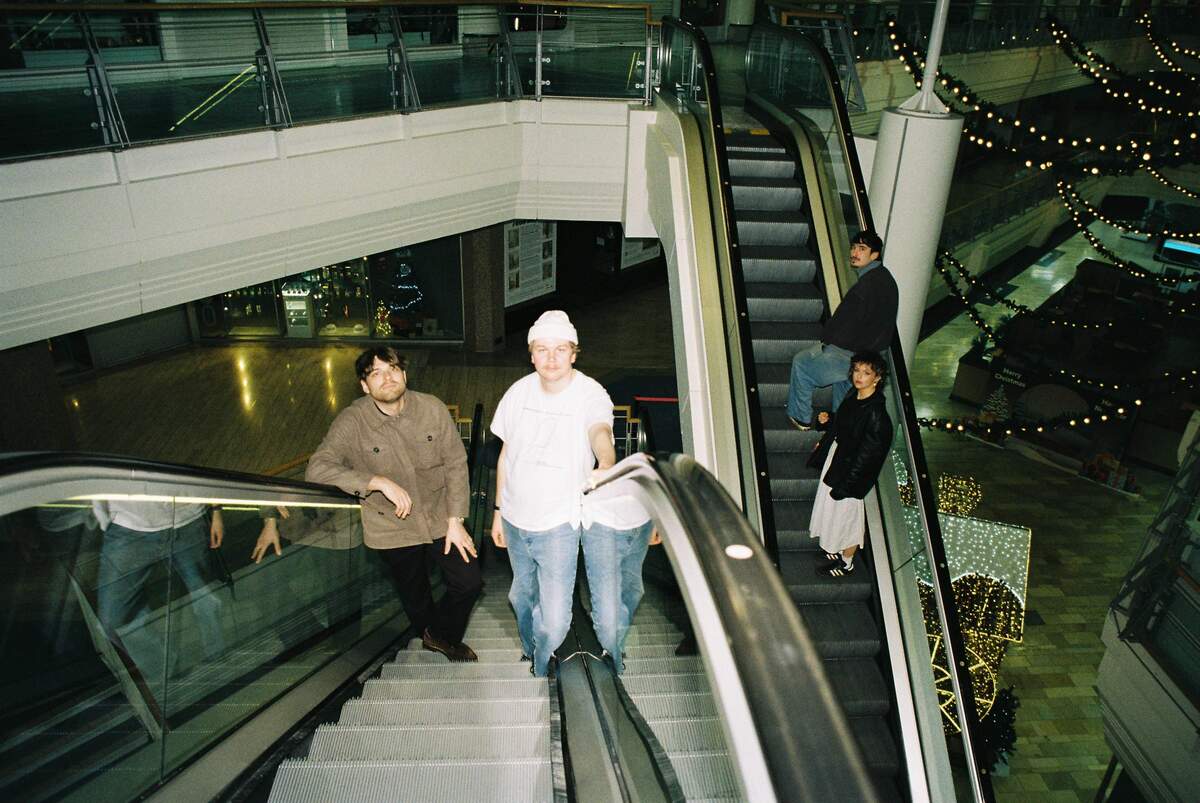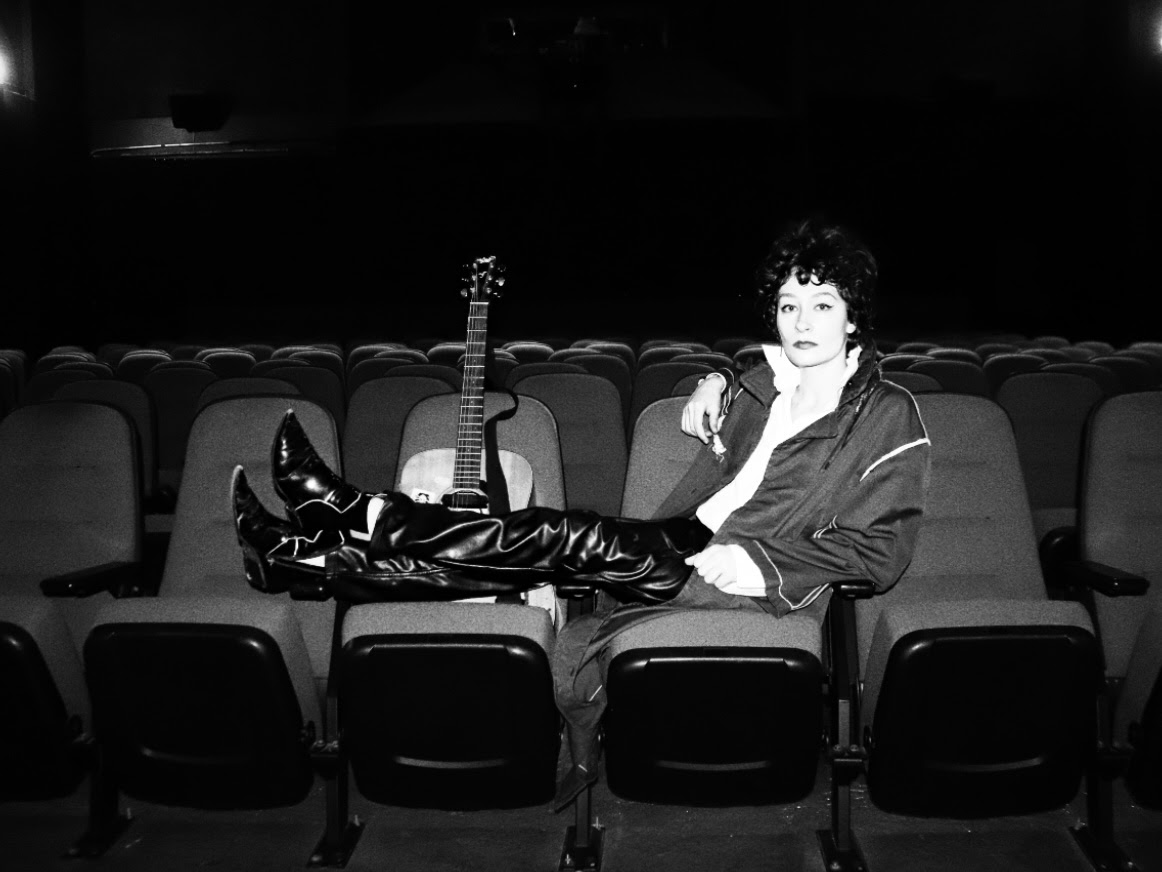Divine Horsemen | Interview | “I was sick of the direction rock music was headed” | New Album, ‘Bitter End of a Sweet Night’
LA’s own Divine Horsemen are back with the second album, ‘Bitter End of a Sweet Night,’ since their 2020 return, out via In The Red Records.
L.A.singer/songwriter/author Chris D.’s post-Flesh Eaters band with Julie Christensen (who toured with Leonard Cohen) has reunited in 2020. ‘Hot Rise of an Ice Cream Phoenix’ is the band’s first release in 33 years, which was followed with the release of ‘Bitter End’ in 2023. The new 16-track collection again features the band’s co-founding members, singers-songwriters Chris Desjardins (better known as Chris D.) and Julie Christensen, and the core members of the ferocious “Hot Rise” band — guitarist/co-writer Peter Andrus (a member of the group’s late-‘80s lineup), bassist Bobby Permanent and X’s nonpareil drummer DJ Bonebrake (who won’t be doing “live” dates). The sound is filled out by Green On Red and Dream Syndicate keyboardist Chris Cacavas (who appeared on the 1984 Chris D./Divine Horsemen album ‘Time Stands Still’) and classically trained violinist Elizabeth Wilson. Desjardins produced the album.
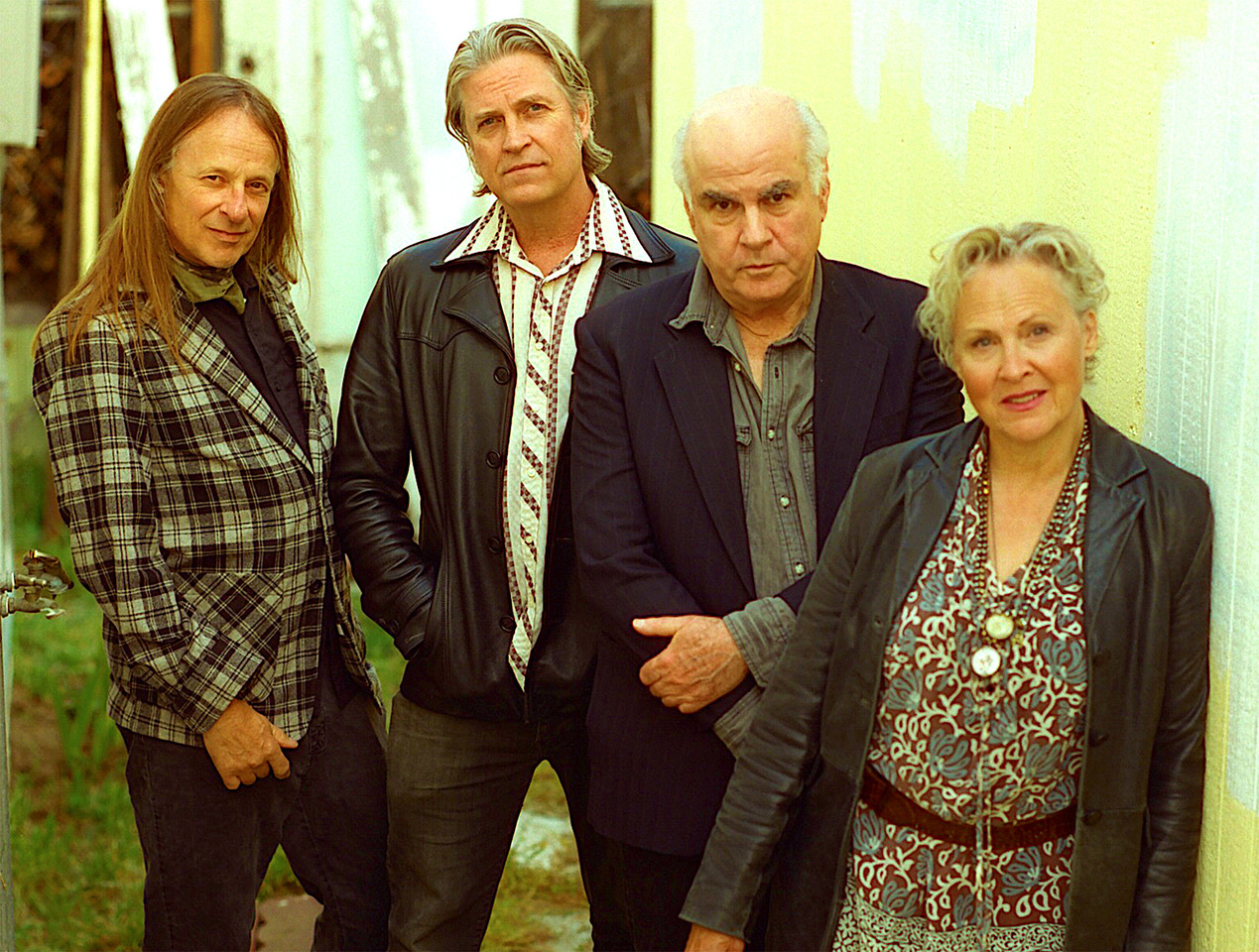
“I am generally working on stuff as the spirit (or the guilt) moves me”
It’s truly wonderful to have you. How are you doing? I see that you’re keeping busy?
Chris D.: Yes, trying to keep busy. These days I start feeling guilty if I’m not doing anything productive. Which is ridiculous, when I immediately contemplate our microscopic place in the cosmos. So I am generally working on stuff as the spirit (or the guilt) moves me, often in the wee hours between 11 pm – 4 am, then trying to sleep until 1 pm. It’s kind of a luxury to do that, but part of it comes with age, getting social security payments and having a little bit of savings. I’ve written (and I am still rewriting) lyrics for about 12 new unrecorded songs in the last year, working on a massive book which will feature both past and new film writing, which may end up being around 600 pages long. I just started laying it out, even though I still have about a half of the writing to finish. And of course Divine Horsemen are available for “live” shows (to a limited degree) to support the newest album ‘Bitter End of a Sweet Night’ on In the Red Records. Since Summer of 2023, Divine Horsemen has been playing with a new permanent drummer, Johnny Ray (who played drums on the 1999 Flesh Eaters album ‘Ashes of Time’).
How much time and effort went into creating Divine Horsemen’s new album ‘Bitter End of a Sweet Night’?
It had a long gestation, partly because it was written and planned by me during 2021 in the middle of the lockdown, then we rehearsed it at the end of the year, and finally recorded and mastered it right at the tail end of the pandemic in January 2022. We also had to wait in line for scheduling the release date due to other releases that had dates ahead of us AND the fact that pressing plants are still not as fast as they used to be at churning out vinyl.
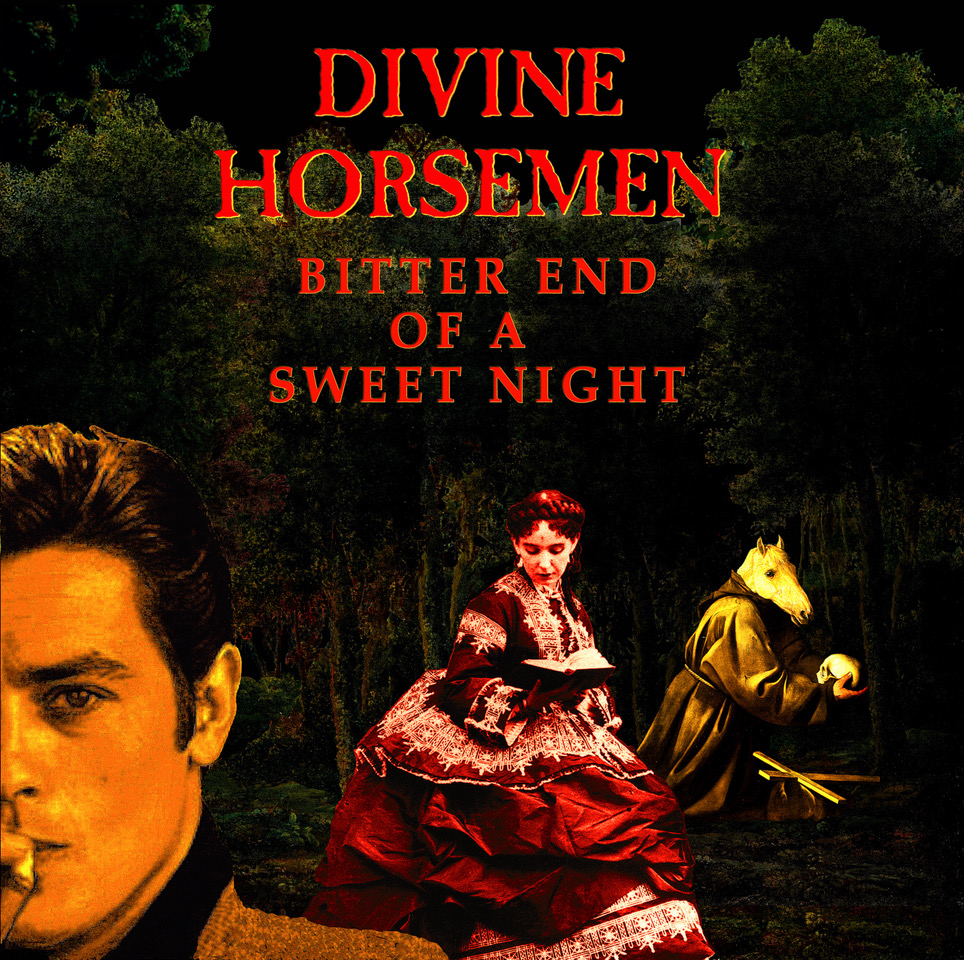
Would love it if you could share some words about the recording and producing process for it.
Considering the limitations, it actually went a bit smoother and faster than our previous album ‘Hot Rise of an Ice Cream Phoenix’ which we recorded and mixed in October/November 2019 but which wasn’t released till August of 2021. This newest one had its own set of challenges. Even though he had not been doing “live” dates with us (and never has), DJ Bonebrake from X came back on drums. However, at the end of 2021, he’d been out on the road with X for quite a few dates, and everyone on the tour came home with Covid except for him. His wife made him promise he wouldn’t leave the house for a few months. So luckily DJ is not only an incredible drummer, he also recorded all his drum tracks remotely in his backyard studio (difficult but not impossible) which ended up sounding as good as if he’d been right there in the same studio with us.
Tell us about the songs featured on the album.
When I was home for days on end during the pandemic in 2020-2021, even before our already-recorded Divine Horsemen album ‘Hot Rise of an Ice Cream Phoenix’ was released in August 2021, I was writing pages of stream-of-consciousness prose/poetry for a new album, usually while listening to other people’s music – from UK ’60s psychedelic band The Creation to early Rolling Stones to The Stooges to The Fall to Nick Cave and more recent music by Smoke Fairies (a lot of Smoke Fairies!) and even Lana del Rey (!). I wasn’t appropriating words from their songs, but using the feelings I was getting from their music to come up with my own words. And my lyrics almost invariably end up being about past relationships or fictional relationships – usually dysfunctional. When I had about 10 or 15 solid pages written out in cut-up-type William Burroughs-style prose, I began carving out lyrics for songs. The words to ‘Talking in Your Sleep Again,’ ‘You Knew No Other Way,’ ‘Vanina Vanini,’ ‘Dirty Like an Angel,’ ‘On the Wane’ and ‘Footprints on the Moon’ all came out of that. I showed Peter Andrus, our guitarist, the crude chord progressions I had for those, and he polished them up and added his own feeling to the music. Also the words to ‘Bitter End’ came from that process, but Julie wrote the music for that one. The words to ‘Notorious,’ I was influenced again by my fascination with the “duende,” the evocative morbidity of flamenco music, which has a similar kind of feel to the moody, dark murder ballads of 19th century America and the British isles. We had already done a couple of flamenco/gypsy-influenced songs on the ‘Ice Cream Phoenix’ Horsemen album. ‘Notorious’ is a sort of prequel in subject matter to those earlier pieces ‘Barefoot in the Streets’ and ‘Stony Path’ from that record. Doomed, obsessive star-crossed lovers who end up murdering each other in the final song ‘Stony Path’. When I sent Julie the words for ‘Notorious,’ I told her to listen to the creepy, mournful cajun waltz on the end credits of director Betrand Tavernier’s crime film In the Electric Mist, which is set in Louisiana, to get a feel for what I thought would work musically with the words. Julie also brought in ‘No Mercy,’ a Divine Horsemen-style-song which she had co-written with outside songwriters for her solo album, ‘The Cardinal’ from 2016. She also brought in ‘These Evils,’ which she had co-written back circa 1990 for a solo album that never got recorded. ‘Memory Fails’ and ‘Garden of Night’ were two of the last songs written in October of 2021, right when we were starting to rehearse the material for recording. I wrote both the words and music to ‘Memory Fails’ very quickly, probably in about two hours, which is almost a record for speed. But I topped it when my close friend, writer Erika Wear, sent me lyrics for ‘Garden of Night,’ a song she had sung in a dream (!) – and miraculously remembered it word for word. I loved it so much, I kept it as is, with no editing. I sat down and had the guitar chords in literally 30 minutes. It was something about her words that made coming up with the riffs very easy. Of course, Peter put his own spin on the guitar riffs once I’d brought them in on both of those. ‘Murder of Courage’ is a song originally from a 1995 acoustic solo album I did ‘Love Cannot Die,’ which was released by Sympathy for the Record Industry. I’d always wanted to do a more hard rock take on it, LOL, and we ended up cutting the last 4th verse for this newer version. Having Julie also singing on that song really adds to the psychodrama. The other three songs were all covers from outside musicians: ‘The Next Man That I See’ was originally done by the late Anita Lane on her album, ‘Sex O’Clock’ in 2001; ‘Coffee Shop Blues’ is an original Smoke Fairies tune from their 2020 album, ‘Darkness Brings the Wonders Home;’ and ‘It’s Still Nowhere’ is by Ed Kuepper (original guitarist/co-founder of The Saints from Australia) from an album he did in 1990 with his band, The Aints called ‘Ascension’.
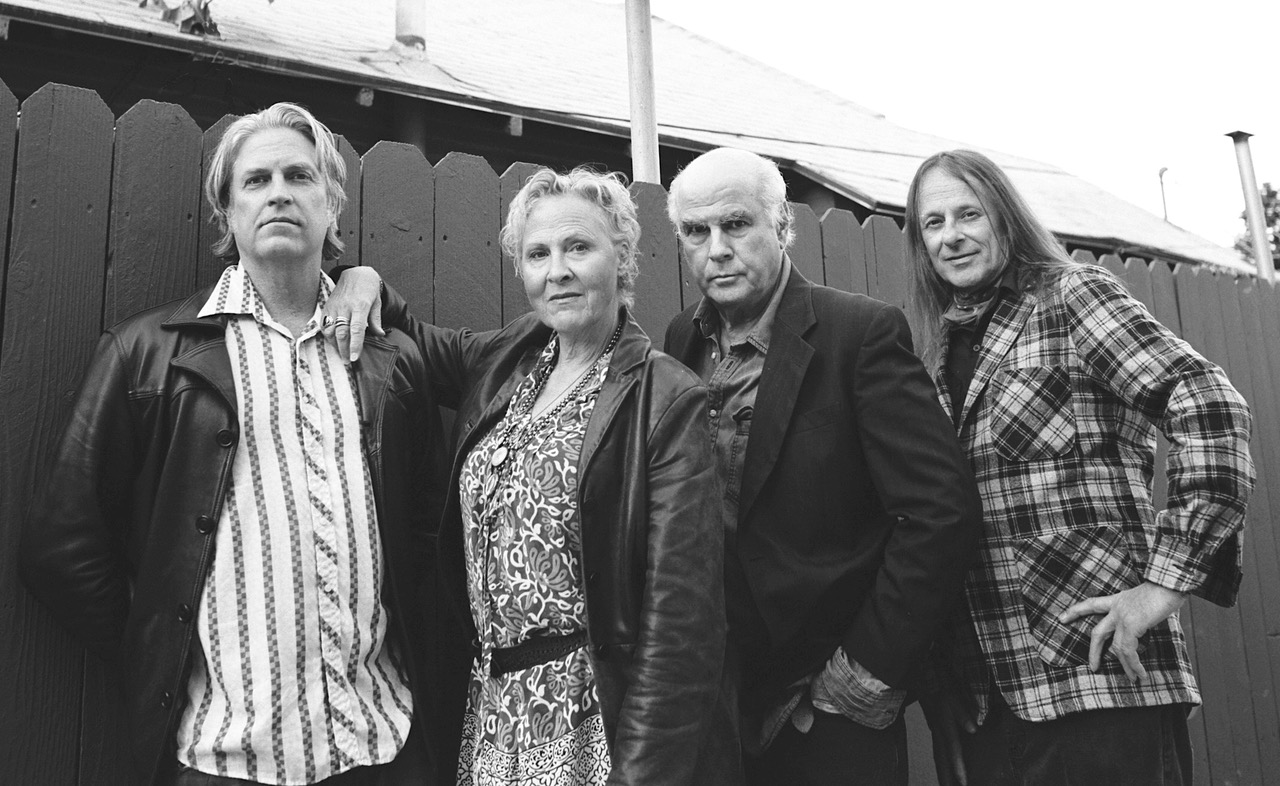
Are you originally from Riverside, California? What was it like growing up there in the 60s? Are you coming from a musical family? What did your parents do?
Yes, originally born and raised in Riverside. I loved growing up there. Though in the early 1970s, when I was already away going to college in Los Angeles, Riverside had acquired a nasty reputation as having the worst smog problem in the whole country! But it was still a small town back in the 1960s, smaller than it is now for sure. It’s really kind of a chamber of commerce/strip mall hellhole in this day and age. And all the four great old time movie theatres I was going to in the sixties are long gone now. Riverside and San Bernardino used to be the drive-in movie capital of the Inland Empire in the 1950s – 1980s, but most of those are gone now, too. My family wasn’t particularly musical, but I did take piano lessons briefly from a very terrifying nun when I was 7 or 8. That didn’t work out, but we ended up having a piano in our home until my parents went into assisted living in 2001. I seemed to have an affinity for creating melodies but I could not retain what I learned about reading music. It was just too mathematical. And my dexterity with my fingers on both keyboards and guitar frets has remained clumsy and rudimentary at best till this day. I can sort of write music on guitar off-and-on since about 1985, but still I have no idea what I’m doing. I can’t talk to other musicians in a musical vocabulary, so I have to record crude videos of what chord progressions I come up with so they can see exactly what I’m doing. My dad was a professor of plant pathology, a scientist at UC Riverside, doing research and teaching. My mom was a housewife (and I think a frustrated artist) until all of us kids were in school. Then for around ten years or so she was the secretary for the all girls Catholic high school downtown. By the time my brother and sister and I were in college in the seventies, she started working at the administration offices at UC Riverside. My brother now does DIY fabric patterns design from his home and my sister and her husband have been professors at Dartmouth in New Hampshire for at least the last 15 or 20 years.
How would you describe the music scene there when you were still growing up? Did you attend a lot of shows? Do you remember any remarkable performances that stayed with you forever?
There was no local music scene in Riverside back in the 60s. At least that I knew of. Of course there were longhair kids on various neighborhood blocks playing rock n roll in their parents’ garages. But there was nothing organized around a unifying genre like punk rock where even non-musicians – in other words kids who didn’t know how to play or sing – were welcome. I didn’t even try to get involved because I felt hopeless as a musician. I also was much more interested in filmmaking at that time and writing. I made a lot of Super 8 movies in high school, which are now long gone. At home I was listening to Cream, The Doors, Steppenwolf, The Rolling Stones, The Beach Boys, Jethro Tull, Free, Jefferson Airplane, Savoy Brown, Led Zeppelin, Jeff Beck Group, Ten Years After, The Velvet Underground (the VU came a bit later, like right around summer of 1970 just before I went to college). My parents didn’t really let me go out to the big concerts at Swing Auditorium in neighboring San Bernardino until I was 17, just before I started college in Los Angeles. There had been a show with Janis Joplin and the MC5 at the Swing I really wanted to see, but nope, I was not allowed because I was only 16. Later on around 1970 – 1971, I saw a lot of shows at The Swing. Lee Michaels, Traffic, Fleetwood Mac (‘Kiln House’ era, after guitarist Peter Green had left but several years before Buckingham/Nicks joined and kind of ruined them), Johnny Winter, Leon Russell, Elton John, Steppenwolf, Led Zeppelin, Jethro Tull (right between their 3rd and 4th albums, ‘Benefit’ and ‘Aqualung,’ which is when they were quite good – once ‘Thick as a Brick’ came out I could no longer listen to them; they had gone too heavy concept / bloated prog rock). I almost saw one of Jimi Hendrix’s last shows, I had tickets, but they closed the doors right before I could get in, and there was a riot. The police tear gassed people who were still outside. The promoters got into trouble because they’d oversold the show, and they were forced to refund a lot of tickets. Later on, in Los Angeles in the early 1970s I saw shows at big places like The Forum, Santa Monica Civic, The Long Beach Arena, as well as smaller clubs like The Whisky a Go Go. I saw The Rolling Stones, The Faces, Foghat (LOL), Savoy Brown (unfortunately after great singer Chris Youlden had left), Sly and the Family Stone, Rory Gallagher, more Johnny Winter, ‘Killer’-era Alice Cooper. Probably the most impressive shows I saw in the early 1970s were the first two David Bowie/Ziggy Stardust concerts, then his return the next year doing ‘Aladdin Sane’. At smaller clubs, without a doubt the most influential was getting to see The Stooges a year or two after ‘Raw Power’ came out, right before they broke up. I got to see them at least 3 or 4 times at The Whisky. Incredible. I also caught The New York Dolls at The Whisky and The Hollywood Palladium around the same time. They were good but not quite as good “live” as they sounded on their first album. I saw Mott the Hoople and Family. I saw Patti Smith when she first played The Whisky, a year or two before ‘Horses’ came out in 1976. She just had Lenny Kaye and Richard Sohl backing her on guitar and piano. No bass player or drummer.
If we would visit your teenage room, what kind of records, posters, fanzines and books would we find there?
I already mentioned the kind of albums and 45s I was listening to in a previous question. I had two big posters from movies in my room, both giant blow-up B&W photos that were really popular right then: one with Steve McQueen riding his motorcycle in the movie ‘The Great Escape’ and one with unshaven Clint Eastwood from Sergio Leone’s ‘A Few Dollars More’ where he’s holding the rifle in one hand and a pocket watch in the other. There really weren’t any fanzines I was aware of while I was still living at home, although I did read the Los Angeles Free Press and early Rolling Stone (which was really going through its first and best period right then at the end of the sixties). Once I was away at college, I discovered Creem magazine, then around 1972, Rock Scene (which was very heavy on glam/glitter band coverage, from Bowie to The New York Dolls to Mott the Hoople to Todd Rundgren to The Sweet to Roxy Music to Silverhead, The Stooges, Lou Reed, et. al. As far as books when I was in high school, I was reading a lot of science-fiction, Edgar Allan Poe, ghost stories by J. Sheridan Le Fanu and Algernon Blackwood, the Sherlock Holmes books, and just starting to get into hardboiled crime fiction from classic authors like Raymond Chandler, Dashiell Hammett, James Cain, to more contemporary crime writers like Ross McDonald (who had had two of his novels adapted for movies with Paul Newman, ‘Harper’ and ‘The Drowning Pool’).
How did you become a feature writer at Slash Magazine and what kind of experience was that for you?
I had just come back from Europe with my first wife, Bonnie and, when we were in London, I had gotten the debut albums by The Sex Pistols, The Clash, The Saints (from Australia), The Damned and The Vibrators. Once when we were out at the movies at the Nuart Theatre in West L.A., we went to Papa Bach’s Bookstore which was across the street, and I saw the very first issue of Slash on the bookstore’s newsstand at the front of the store. Of course, I fell in love with it. I had been writing very surreal, cut-up style poetry since about 1973 or 1974. And Bonnie and I had DIY-put out a poetry anthology called ‘Bongo Chalice,’ which printed our stuff and some other L.A. poets, and reprinted a couple of Patti Smith’s poems, with her permission (or rather Patti’s mom’s permission – LOL). I doubted Slash would print poetry, but it was the closest thing to punk cred that I had going for me. To my surprise, Philomena (who edited the mag with her boyfriend Claude ‘Kickboy’ Bessy), sent me a letter telling me that they really liked my poetry, but that Slash didn’t publish poetry. But she asked me if I wanted to try to write records and “live” show reviews for them. I sent them a review of Iggy and the Stooges’ 45 ‘I Got a Right/Gimme Some Skin’ and they accepted it. That was in the third issue in mid-1977. I gradually started writing more and more for them. I and the rest of the writers were going to the Masque every week to see the new L.A. punk bands. When I first saw X, I realized I had met John and Exene already in 1976 at Beyond Baroque in Venice, CA, an organization which is still around and is a kind of literary non-profit that had its roots in the Beat era, if I’m not mistaken. I became friends with John and Exene. By that time, I was in the middle of a divorce from my first wife and was teaching English at a private high school down by LAX. My new girlfriend and I used to go over to X’s practice space and watch them rehearse. This was right before they did their first single with Dangerhouse, ‘We’re Desperate’/’Adult Books’. I also met some great people through the magazine like artist Lou Beach, writer/musician Jeffrey Lee Pierce, writers Will Amato, Allan MacDonnell. I met all The Blasters guys in 1980 when John and Exene took me to a party in Downey at the house where Dave Alvin was living. Dave positively floored me when he told me liked the ‘No Questions Asked’ album, and I realized how broad his musical tastes were. If you want to know more about my Slash writing and read all the reviews I wrote for them, you can get my book ‘Writing for Slash 1977 – 1981: The Know-It-All Years’ which I self-published through Amazon in 2022.
Did you and your friends have any special hangout places where you could listen to music and just do stuff?
Not in high school, unfortunately But later in college, first in the dorm rooms, then later in rented houses I shared with my roommates off-campus. Once I discovered Slash magazine and The Masque, the last question kind of covers that.
How would you describe the original LA punk scene?
It was like suddenly being told, yes, you’re a creative person who has a vision and you DO NOT have to be a perfect musician (or even a musician at all, in the traditional sense) to start a band. Of course, there was a lot of mediocrity that resulted, but also a tremendous amount of great stuff. What a liberation it was for truly talented people who had always felt kind of shut out of even traditional rock music because they were a little too weird or a little too arty or couldn’t always sing on key, or the music might be too angry or dissonant. Suddenly there were bands all around you that you liked as much as you had liked more famous, seemingly inaccessible groups. X, The Alley Cats, The Weirdos, The Germs, The Screamers, The Bags, The Skulls, then Black Flag, The Minutemen, The Blasters, The Gun Club and The Circle Jerks. I saw so many great shows back then from local bands. But there were great bands from out of town. I saw The Damned, The Jam and The Selecter when those bands played the Whisky. I saw The Birthday Party twice in one night at The Roxy. Jaw droppingly good. The Flesh Eaters got to open for The Professionals (with Steve Jones on guitar and Paul Cook on drums). I saw The Cramps in numerous incarnations. We got to open for them once. We got to open for The Fall and Blurt (actually The Fall is the only relatively world-renowned band besides X where we got to open for them as both The Flesh Eaters AND Divine Horsemen). And Divine Horsemen got to open for people as disparate as John Cale and John Hiatt. So lots of phenomenal memories.
“I was sick of the direction rock music was headed”
What led to the formation of The Flesh Eaters? What was the overall vision of the band?
I was sick of the direction rock music was headed. Good blues rock bands from the late 1960s UK like Fleetwood Mac, Savoy Brown, Led Zeppelin and Ten Years After we’re diluting and homogenizing their sound. The only Allman Brothers album I really liked back then (and still now) was the first one. Even idols like Bowie, Iggy and Lou Reed were seemingly losing their edge. I was enormously influenced by The Stooges, The MC5, The Sonics and I wanted to continue more in that direction, but maybe with the more eccentric, cryptic lyrics of people like Mark E. Smith from The Fall and Patti Smith.
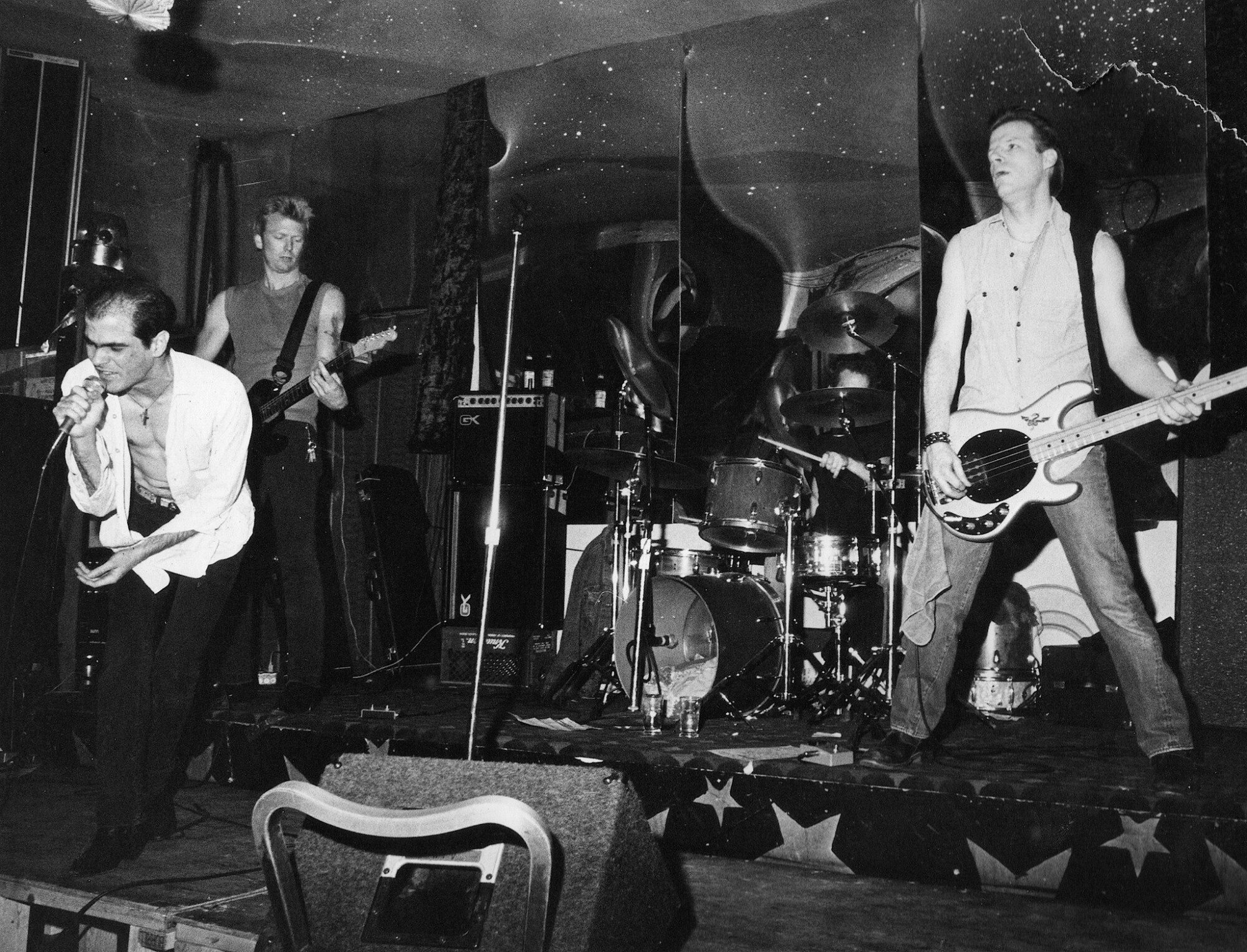
Would love if you could comment on the making of ‘No Questions Asked’ and the follow-up, ‘A Minute to Pray, a Second to Die,’ which featured John Doe and DJ Bonebrake from X, as well as Dave Alvin, Bill Bateman, and Steve Berlin from The Blasters.
I put together ‘No Questions Asked’ when I didn’t have a consistent, viable “live” incarnation of the band. I’d had The Fly Boys backing me up as The Flesh Eaters on the first 4 song EP, which had ‘Disintegration Nation’. For two of the songs on The Tooth and Nail compilation, The Flesh Eaters had Rand McNally (Pat Garrett) from The Randoms on guitar and John Doe from X (and also The Randoms) on bass, and DJ Bonebrake from X (and The Eyes) on drums. Exene from X and my girlfriend, Judith Bell sang backing vocals. ‘No Questions Asked’ really followed that patchwork line-up. Some songs on the album had John Doe and DJ Bonebrake on bass and drums. Some songs had Karla Maddog from The Controllers on drums and John Richey (from the original Flesh Eaters line-up) on bass. Most of the songs had Joe Ramirez from The Eyes on guitar. Some of the tracks were recorded by Randy Stodola of The Alley Cats on 4 track at his living room in Lomita, and others were recorded on 8 track by Larry Duhart at Program Recorders on Selma & McCadden in Hollywood, which was about a block or two south of The Egyptian Theatre. I was learning the ropes on what to do and what not to do in recording music. Both the singing and the production on that album – those songs are kind of hard for me to listen to now, though I think the lyrics and some of the music stand up.
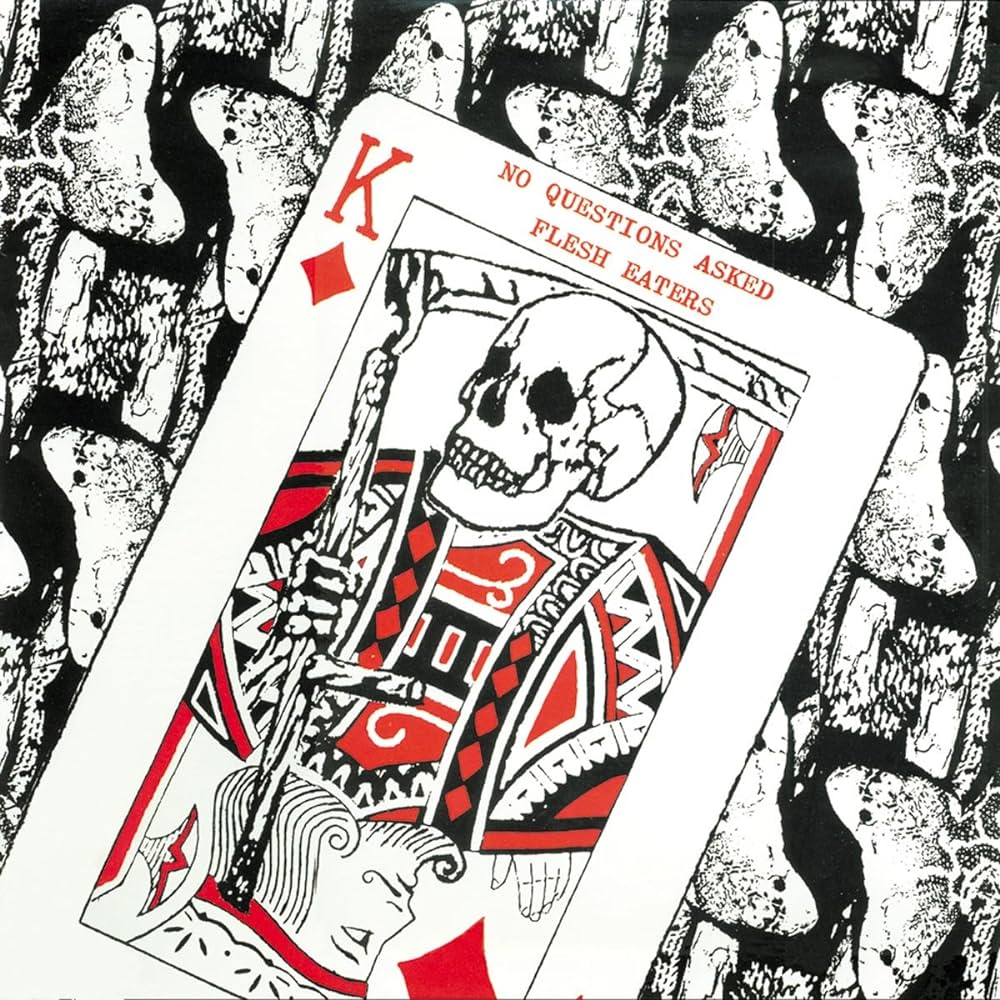
‘A Minute to Pray, A Second to Die’ was only the second album but it was approached very differently. I’d been working at Slash Records for about a year, and Bob Biggs, the owner, put up the very low budget for the album. I had pulled together Dave Alvin and Bill Bateman from The Blasters, John and DJ from X, and Steve Berlin (who had not joined Los Lobos yet, but had been playing sax around town with Top Jimmy, Beechy and The Beechnuts and sometimes The Blasters). We rehearsed intently for 2 or 3 weeks, then went into record.
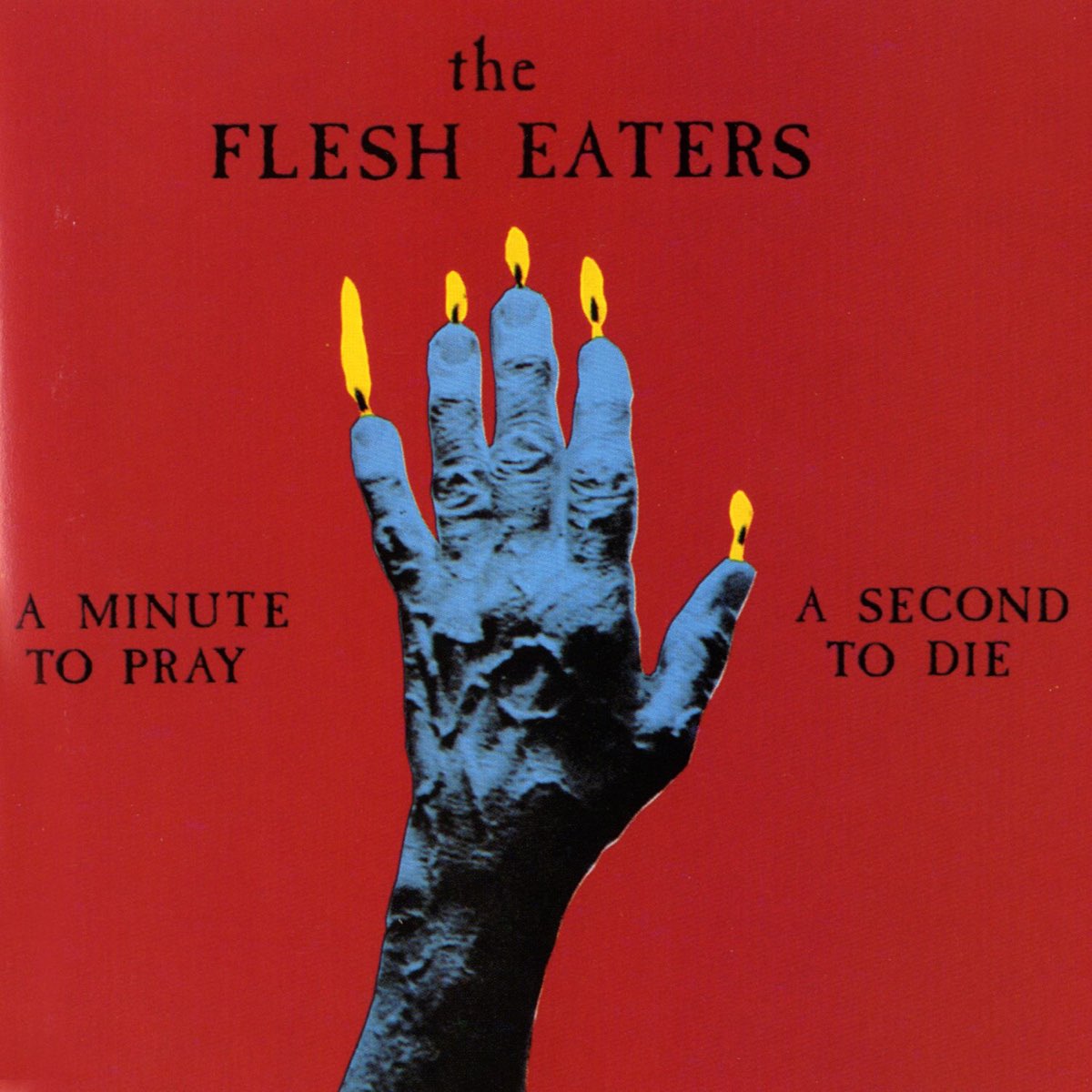
Our first attempt at doing a “live” 2 track recording of the album at Rene Daalder’s studio space didn’t work because it was too echoey. The one song we saved from that session that’s on the album is ‘Satan’s Stomp’. But we re-recorded and mixed the other 7 songs at 24 track Quad Teck Studios, with Pat Burnette as engineer (he’d engineered The Germs G.I. album there). We had one night to record the songs, then 2 or 3 nights to mix.
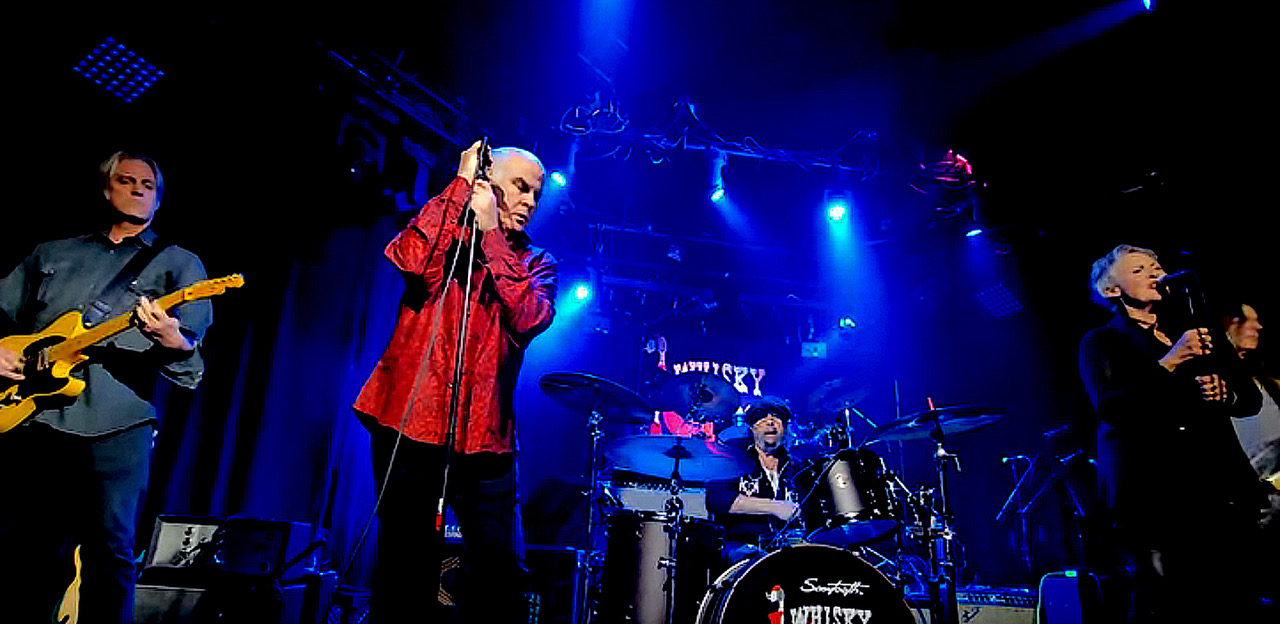
What about ‘Forever Came Today’ and ‘A Hard Road to Follow’? What do you recall from working on those two final albums for The Flesh Eaters?
By the very nature of who was in the ‘Minute to Pray’ line-up – musicians who were in other more successful bands – we couldn’t stay together very long. It’s a miracle we were together for almost 6 months. So in September of 1981, I began auditioning people for a new Flesh Eaters line-up. Guitarist Don Kirk and bassist Robyn Jameson got recruited almost immediately (just from ads I’d put in a giveaway newspaper called The Recycler available at convenience stores). But it took a couple more weeks to find a suitable drummer. We auditioned several people, but they were not working out. We almost had Cliff Martinez as a drummer. My memory is kind of hazy. If I remember correctly, I think we liked him but he may have passed on joining. I know he later played with The Weirdos for a while. More recently he’s been doing fabulous soundtrack scores for some of Nicolas Winding Refn’s movies like ‘Drive’ and ‘The Neon Demon’. Finally we were lucky to find Chris Wahl for a drummer, and we commenced rehearsing the songs for the ‘Forever Came Today’ album, which was recorded in early 1982 and released a few months later.
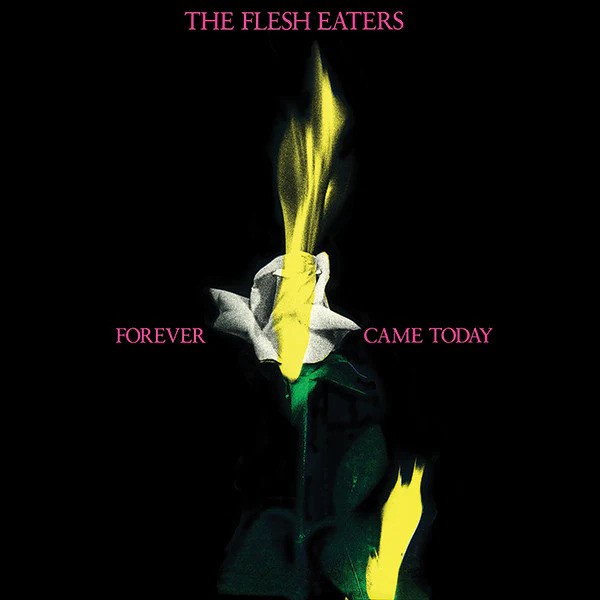
Steve Berlin came back and played sax on 6 or 7 songs, but he wasn’t as high volume in the song mix, which is something I’ve often regretted. That album was also released through Ruby/Slash around the same time as The Gun Club’s ‘Fire of Love,’ which I had co-produced. We went and recorded ‘A Hard Road to Follow’ in 1983, but Bob Biggs had declined to fund the record. He wasn’t as keen on the final result. I ended up borrowing the money from my good friend Byron Coley’s mother-in-law, Maria Dwight (although I don’t think Byron and Lili had gotten married yet). That record was not as polished and the recording was more rushed than ‘Forever Came Today’. Some of the songs, the guitars were too loud and distorted, and I had been drinking too much when I had recorded a few of the vocal tracks. Even though I was still working at Slash/Ruby, that album was released in 1983 on my own label, Upsetter Records.
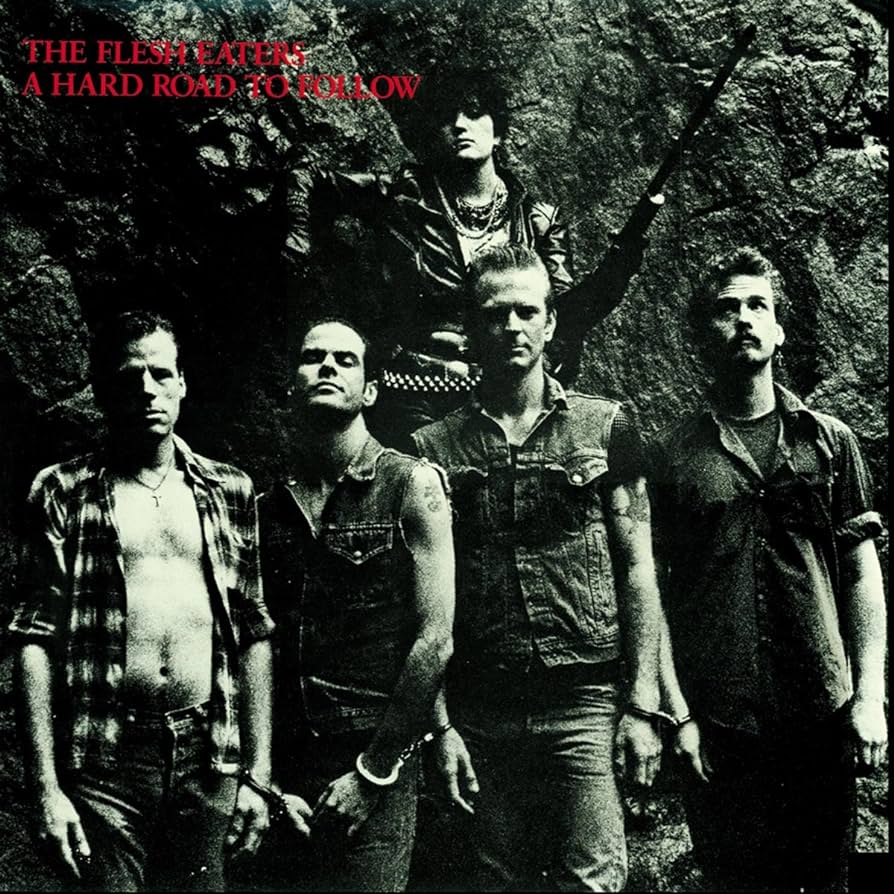
What initiated the Divine Horsemen?
By the end of 1983, I was getting sick of playing super-loud music all the time. We were losing the dynamics in the songs. Plus, even though I got along with all the guys in the Flesh Eaters band individually, I often watched from the sidelines for the first half hour or hour of each rehearsal with the other three bickering over stupid stuff. There was some antagonism at the time between Robyn and the other two guys, Don and Chris. It had started when we had been on a nationwide tour in the summer of 1982. It would get better for a while, then – off-and on – they’d renew old arguments. I was already wanting to try an acoustic approach to the songs I was writing, so that’s what happened. I broke up that line-up of The Flesh Eaters at the end of 1983. I got a solo one record deal with Enigma to do what became ‘Time Stands Still,’ which was recorded and released under the name Chris D./Divine Horseman in 1984, just as I was parting ways with my job at Slash Records. (Note the singular in the band name: HorseMAN). I had met Julie while she was singing backup on a country song I was producing for Top Jimmy, and I asked her to sing back-up on most of my record. She also sang co-lead vocals on a couple of the songs. There were a lot of friends who came in to play on individual songs. Dave Alvin, John Doe, Bill Bateman from The Blasters, Kerry McBride of The JuJu Hounds, Dan Stuart and Chris Cacavas from Green on Red, Jeffrey Lee Pierce and Kid Congo, Slim Evans from Rank and File. Robyn Jameson came back and played acoustic guitar on a few of the songs. During that period, Julie and I decided to make it a real band.

For a while we played under the Chris D./Divine Horseman name, then changed it to Divine Horsemen in early or mid 1985. We got a solid line-up together with Cam King (who had been in the Texas band The Explosives) and Wayne James on guitars, Robyn Jameson from the previous Flesh Eaters line-up on bass and Rex Roberts from The Kingbees on drums. Between 1986 – 1988 we released 4 records through SST: 3 albums, ‘Devil’s River,’ ‘Middle of the Night,’ ‘Snake Handler’ and 1 EP, ‘Handful of Sand’. The labels were SST in the USA and French label New Rose in western Europe. Peter Andrus replaced Wayne James and Cam King on those last two releases.
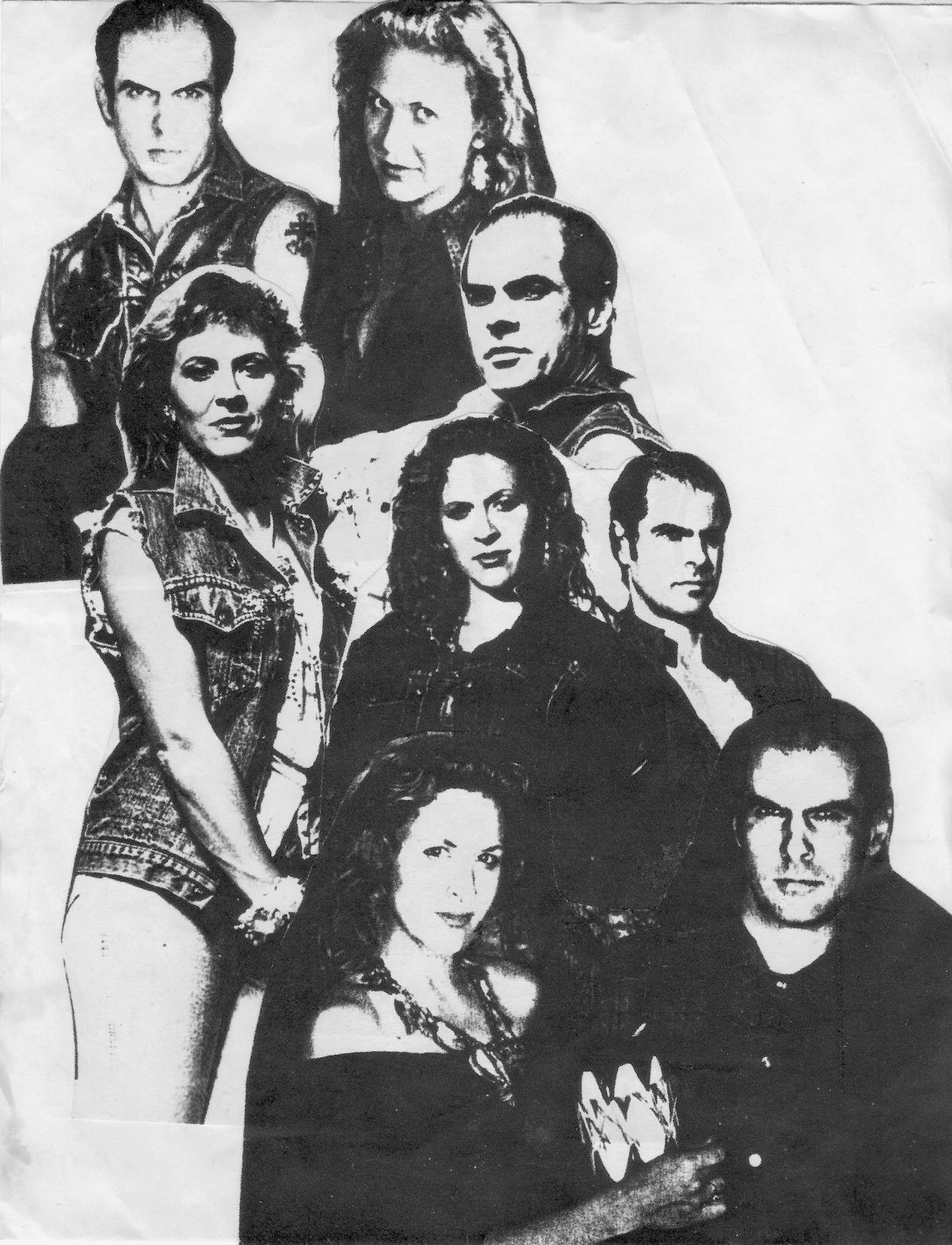
We went on a southwest tour as far as Texas in very late 1985 or early 1986 (not sure exactly), then we went on two national tours in the early spring and early autumn of 1987, both of those with Peter on guitar. Unfortunately, both Julie and I had picked up heroin habits in 1986-’87, and Julie got clean for good in August of ’87. I kept trying but couldn’t for another 9 years (in late 1996). Even though I continued to play music with other people in one-offs and other Flesh Eaters line-ups, to maintain her sobriety, Julie could not remain in Divine Horsemen with me still using, so both the band and our marriage broke up in very early December of ’87.
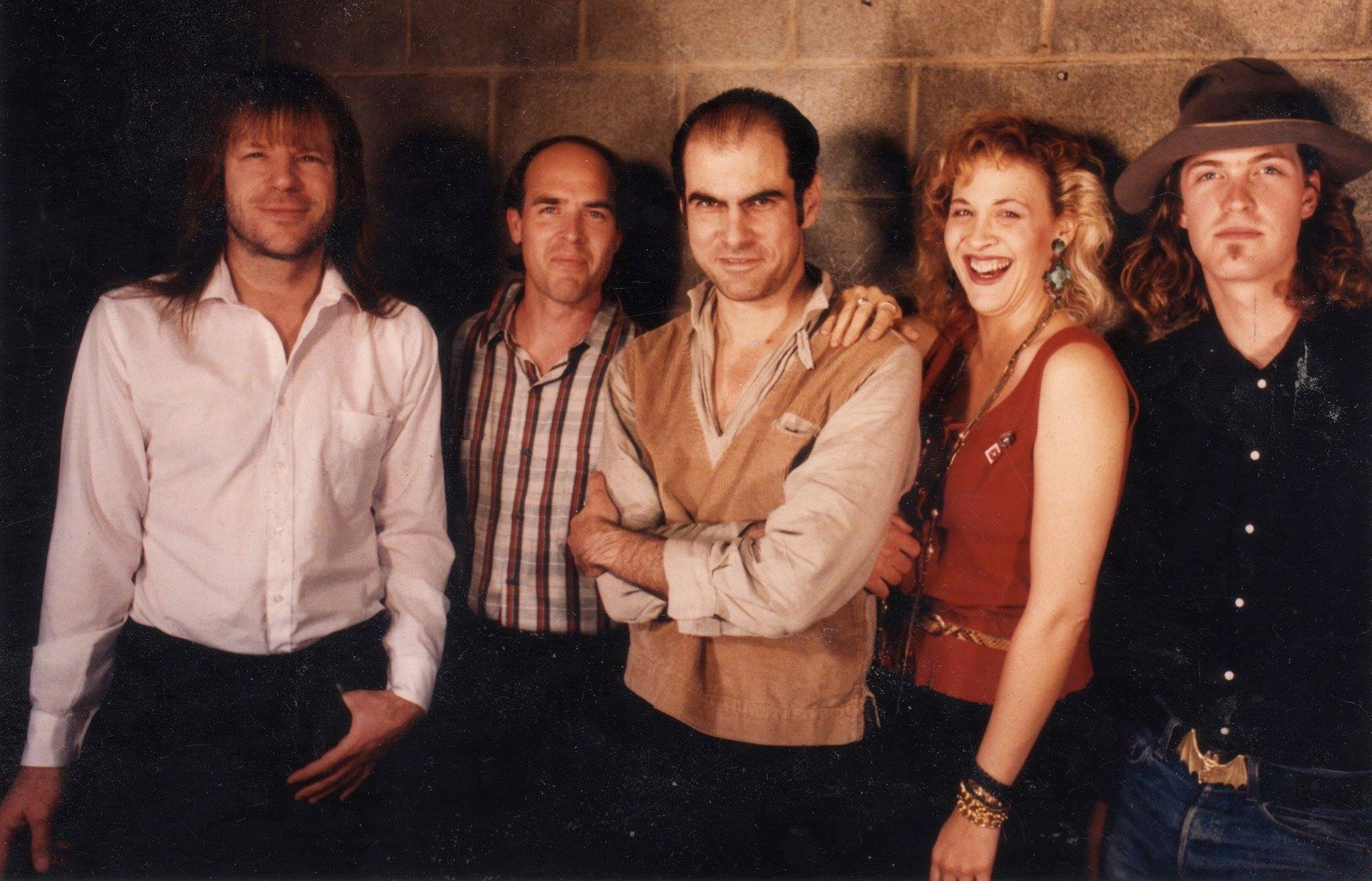
What’s it like to be back together reformed?
I let Julie know in early 1997 that I had a couple of months sober, and we started being on speaking terms again. But she was remarried and had a son. She had also toured with Leonard Cohen for a couple of years in the early 1990s doing backing vocals. We kept in touch and, when I did a couple of Flesh Eaters albums, ‘Ashes of Time’ and ‘Miss Muerte’ with other line-ups in 1999 and 2004, Julie came in and sang back-up on some of the songs. She also did 2 duets with me on 2 of the songs on the 2004 ‘Miss Muerte’ release. But we never played ‘live’ with that Flesh Eaters line-up. At that time, I was working full-time at The American Cinematheque (between 1999 – 2009). I ended up doing a few reunion shows with the ‘Minute to Pray’ Flesh Eaters line-up in 2006, which Julie was not involved in. Sometime in 2014 or 2015, Julie had floated the idea to me about maybe doing a Divine Horsemen reunion. I was open to the idea, but I wasn’t ready to do it right then. We kept in touch. I did the ‘Minute to Pray’ Flesh Eaters reunion shows again in 2015, then 2018. Each time we did a few more shows than the previous get-togethers. After the 9 shows in early 2018, I convinced the other guys to record a new Flesh Eaters album with that line-up, which became the ‘I Used to be Pretty’ album on Yep Roc Records. Julie came in and sang back-up on a few of those songs. That album was released in January of 2019, then we went on a tour of 19 cities in the USA in January through March. Julie sang back-up ‘live’ with us in Los Angeles, San Francisco, Chicago, Boston and New York, which were the biggest venues. Julie and I and Peter Andrus had almost gotten together a reunion of Divine Horsemen in the summer of 2018, while there was a lull in the then-current Flesh Eaters activity. But Robyn Jameson, our bass player who was also committed to the project, was suddenly killed in early July when he tried to rescue a woman being savagely beaten on the street by some lunatic. Rather than try to do it without Robyn – and with The Flesh Eaters ramping up to go on tour – we decided to postpone getting the Divine Horsemen back together until late spring 2019. That’s when Peter and I started working on songs for the ‘Hot Rise of an Ice Cream Phoenix’ album. His best friend, Bobby Permanent came in to play bass, and he’s a perfect fit with Peter. I’ve covered a lot of the other details about recording those two newest records in the first two questions here. As far as how it feels to be back together? It feels great to have these 2 latest Divine Horsemen albums out (we also released a full length CD of “live” songs from 1985 – 1987 on Feeding Tube Records in December of 2020), and I know we all feel enormously fortunate to have the support of Larry Hardy and his In the Red Records label behind us for these studio efforts. This latest album, ‘Bitter End of a Sweet Night,’ which came out in October this year, I think is the best album we’ve ever done. At least that’s the way I feel. I don’t know about the other guys.
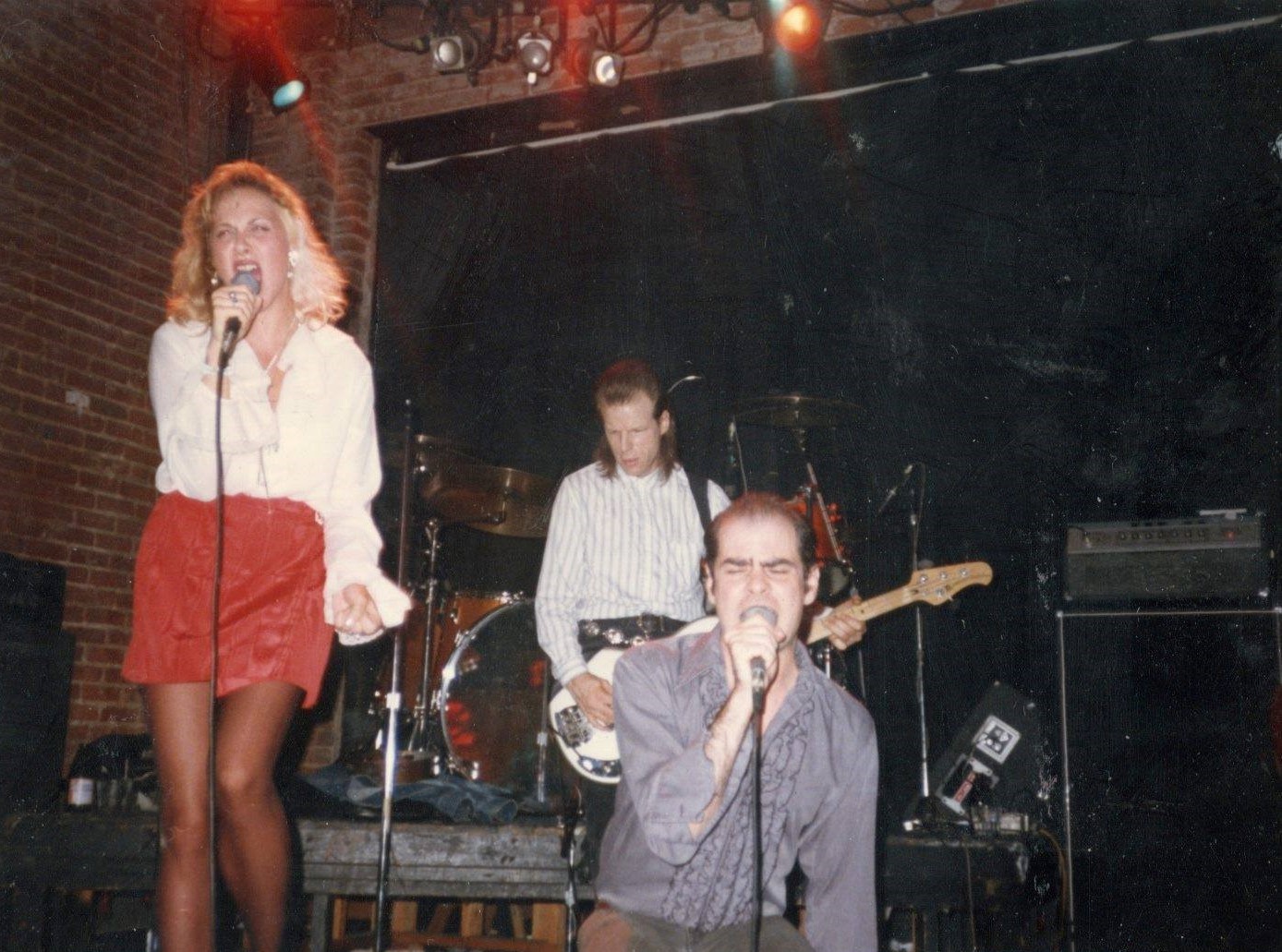
At what stage you became interested in production? You produced some of the truly essential records. I would love it if you could highlight some of the records you were part of.
There were basically two reasons: I didn’t trust anyone else to make my own music sound the way I wanted and, when I started, I couldn’t afford to pay any outside producer. So, the DIY thing again, which I generally still swear by. It really took me a while to learn how to do a good job, though I think I had some good results with some of the other bands I initially produced, such as The Gun Club, Dream Syndicate and Green on Red, because I had a fantastic engineer, Pat Burnette, working with me. I learned SO MUCH from Pat. I can’t overstate that.
We would need days to cover everything you were part of. From the LA punk scene, Paisley Underground, the LA “cow punk” scene to writing two books on Japanese gangster films to poetry and other books. Would love it if you could share some further words about the books.
Well, all I can say is “Folks, go out there and BUY MY BOOKS!” Actually the non-fiction I’ve put out such as ‘Gun and Sword: An Encyclopedia of Japanese Gangster Films 1955 – 1980’ (which is over 800 pages long!) and ‘Writing for Slash 1977 – 1981: The Know-It-All Years’ have sold decently. I’ve also done okay with my collection of poetry/lyrics/dream journals called ‘A Minute to Pray, A Second to Die’. But very few people seem inclined to take a chance on buying my fiction. I have five novels ‘No Evil Star,’ ‘Mother’s Worry,’ ‘Shallow Water,’ ‘Volcano Girls,’ ‘Tightrope on Fire’ and one short story collection, ‘Dragon Wheel Splendor and Other Love Stories of Violence and Dread’ available. All the novels are hard boiled contemporary crime fiction, except for ‘Shallow Water’ which is a Southern Gothic Noir Western set in Mississippi, Louisiana and Texas right after the Civil War. That one was very influenced by James M. Cain’s similar books, ‘Past All Dishonor’ and ‘Mignon,’ and by Cornell Woolrich’s ‘Waltz into Darkness’. All those books are out on my own imprint, Poison Fang Books, self-published exclusively through Amazon (which, to me, is what makes Amazon worthwhile). Go on their site and search by the book title (if you search by my name, Chris D., their stupid search engine will have all the better-selling writers named Chris with the first initial of last name “D” before you ever get to mine). To all the Chris D. song lyrics fans out there: My fiction is GOOD and worth your dollars!
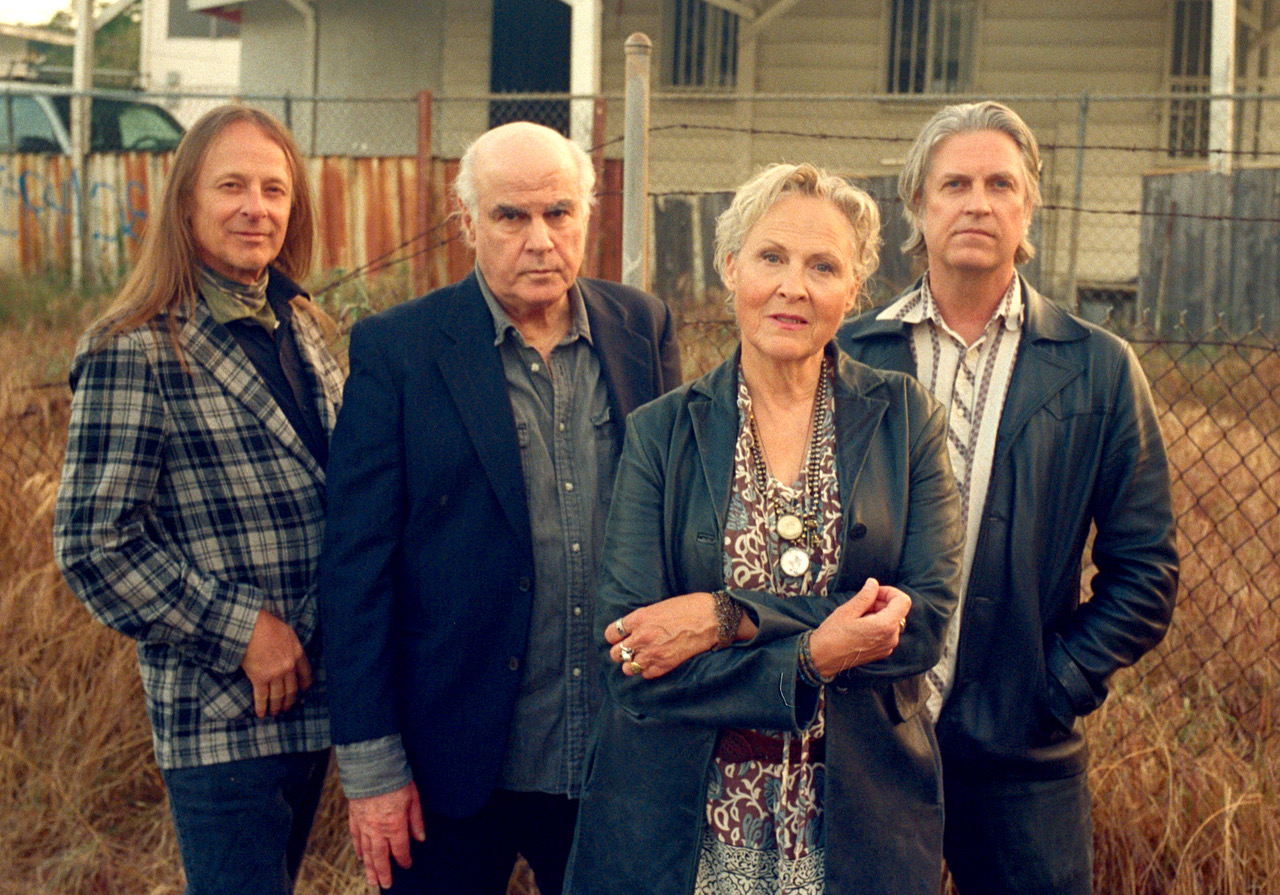
Is there any unreleased material by bands and projects you were part of?
No, nothing at the moment.
Klemen Breznikar
Headline photo: Magnus Diehl
Divine Horsemen Official Website / Facebook / Instagram / Bandcamp / YouTube
The Flesh Eaters Facebook / Instagram
In The Red Records Official Website / Facebook / Instagram / Bandcamp / YouTube

